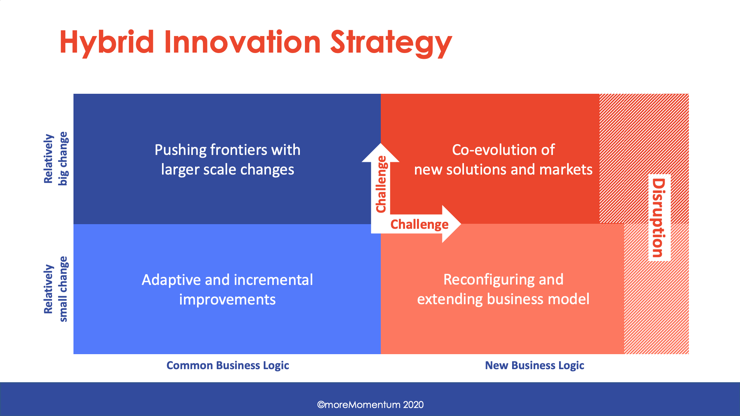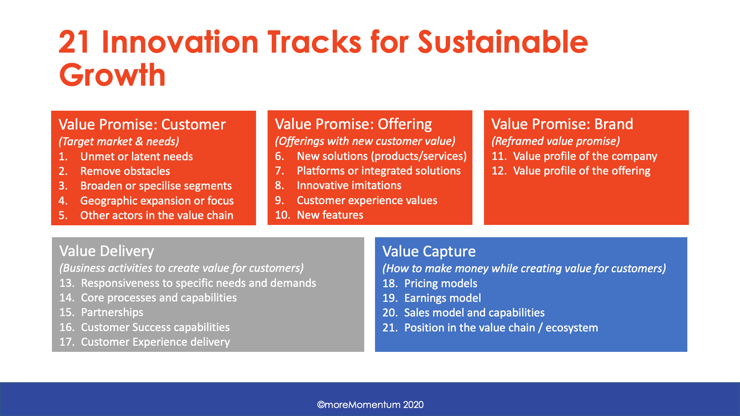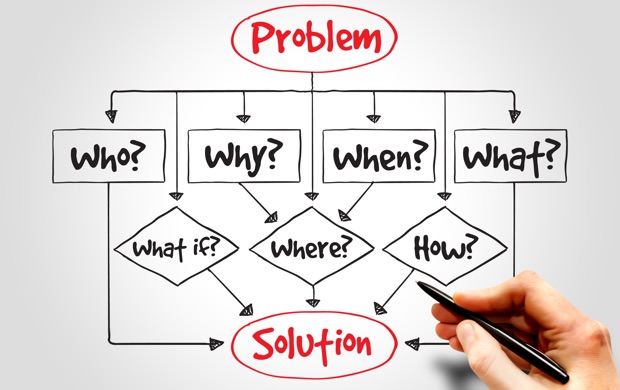Articulate the value of your services for successful monetisation
Monetising advanced services is a mission-critical capability for a successful service transformation. After all, we are all on an exciting journey...

Launching new advanced services is innovating your business model. This requires internal momentum to monetise these services and data-driven solutions.
Watch videoThis article is the 5th and last of my series in which I cover 4 critical steps which make the difference between success and failure in monetising services:
Read my introduction to this topic in Why it is important to monetise services.
Developing new data-driven solutions and services is all about extending the existing business model, which leads to different challenges than many other initiatives and programs in a business. Recognising this in advance will help you understand the challenges and best strategies.
In the previous articles of this series, I have described critical success factors for monetising service and data, like “Solve Bigger Customer Problems”, “Better Articulate the Value” and “Remove Obstacle for Clients to Use your new Offerings”.
In the end, this all has to be achieved by people and teams in your organisation, who collaborate to innovate, to change and transform the business model.
I will first describe common mistakes many companies make, which prevent them to have fluid and energising change and move beyond business-as-usual. This holds them back in monetising services and data, which is critical to thrive in today’s disruptive world.
Many companies, including manufacturers, do not have a clear picture of where the industry is heading and where their business is heading. It is unclear for their employees what needs to be developed and why.
More specific, for many employees it is not clear why the new services and data-driven solutions are that valuable to clients, how it would fit in their overall core business and why it should be paid for by clients. Often, the indicated direction even suggests the opposite: the core value for clients is the equipment or technology and the added value of services and data-driven solutions are explicitly considered as (free) features to support the product sales.
Just imagine how a hypothetical mission statement “… being the world’s leading manufacturer of construction equipment” does not support the idea of monetising advanced services and data-driven solutions.
People in manufacturing often are biased towards products, equipment and technology. They have a too limited view on;
This limited view will hinder product, marketing and innovation managers to develop successful new services and data-driven solutions. Too often we see that the new services and solutions do not really solve an important customer problem and hardly differentiate from services and solutions competitors are offering as well.
It will also prevent colleagues in sales and delivery to understand and support the launch and monetisation of new services and solutions. There is no compelling context.
Too often, we see that developing and launching innovations like new advanced services and data-driven solutions stagnate because of the decision-making habits in an organisation. Typically, we see one or more of the following:
Top-down control mechanisms used since the last decades are a huge obstacle for fluid and energising change in an organisation and therefore hinder initiatives like monetising services and data. More specifically, we often see the following patterns:
Not all innovations and changes are the same. They differ in complexity, risk, unpredictability and time window. Therefore, different challenges and pitfalls are required, from early exploration and ideation up to launching and scaling up.
Most manufacturers maintain a very limited scope on what to innovate and have too little variety of innovation strategies and methods they apply. As a result, the more radical innovations drop off the table or fail.
For example:
Many things come into play when you try to increase momentum for monetising (new) services and data and to avoid creating obstacles and resistance. In general, the more adaptive and fluid the change in your organisation, the easier a specific innovation of service and data will be.
We have seen that leading manufacturers have adopted 5 Momentum Habits which set them apart from the rest. These Momentum Habits define how they lead operations and innovation. In the next paragraphs I will describe these 5 Momentum Habits in relation to monetising services and data.
 Leading companies have a transformative vision and mission on where the business will be heading, what needs to be changed and developed and why that is important considering the changes in the industry. This is a quite holistic picture to which all stakeholders and entities in the business can relate to and get direction on how they should develop themselves, their teams, their departments and their business units.
Leading companies have a transformative vision and mission on where the business will be heading, what needs to be changed and developed and why that is important considering the changes in the industry. This is a quite holistic picture to which all stakeholders and entities in the business can relate to and get direction on how they should develop themselves, their teams, their departments and their business units.
It provides an outside-in picture on how the business is and will be relevant to certain industries and customers. It explicitly points out how the business will add value to clients and which type of client-solutions and services are required.
Now imagine how the following mission statement will catalyse the development and implementation of new services and data-driven solutions: “Our purpose is to enable healthcare providers to increase value by empowering them on their journey towards expanding precision medicine, transforming care delivery, and improving patient experience, all enabled by digitising healthcare”. Don’t you think this is much more compelling and transformative than the bad-practice example I mentioned earlier in this article?
 The innovative and forward moving companies have more variability and diversity in their innovation strategies and organisation, which lead to richer and better initiatives and help to escape from business-as-usual.
The innovative and forward moving companies have more variability and diversity in their innovation strategies and organisation, which lead to richer and better initiatives and help to escape from business-as-usual.
There are 3 main areas in which diversity is critical to pursue: innovation strategies, innovation pathways and team composition.


 Leading companies with a high momentum for continuous innovation and change, empower all teams and individuals to continuously explore for new insights, threats and opportunities, within and beyond business-as-usual. This enables them to be more open to new initiatives and change and develop better ideas.
Leading companies with a high momentum for continuous innovation and change, empower all teams and individuals to continuously explore for new insights, threats and opportunities, within and beyond business-as-usual. This enables them to be more open to new initiatives and change and develop better ideas.
Here I want to focus on two phases of innovating your services and data-driven solutions: the development phase (including ideation, selection and design) and the implementation phase.
Often, the new services and data-driven solutions which are required to thrive in today’s disruptive world, differ significantly from current business logic, mind-set and operations in your business. Even though anyone in the organisation could raise great ideas, it is crucial that the development of the new services and solutions are done by dedicated teams with the right expertise and focus.
They need to ensure they are open-minded and unbounded by current (and old) business logic and pathways. In terms of discovery, this means they should:
Sharing the new insights with stakeholders will help to change perspectives and business logic within the innovation teams and the rest of the organisation.
Once the new solutions and services have been designed and developed to a scalable offering, they probably need to be embedded in the existing organisation. Now the risks of resistance of complacency may come into play.
The more developed the mindsets and habits are on “digital” and change, the more fluid the implementation and change will be. This can be promoted massively by strong discovery habits, like:
 The leading companies have a more distributed ownership and power for decision-making. More decisions are based on experiments when circumstances are uncertain.
The leading companies have a more distributed ownership and power for decision-making. More decisions are based on experiments when circumstances are uncertain.
In line with the mission, vision and direction their leadership have a clear strategic intent on:
Next, they have a clear (top-down) strategy which articulates crucial choices of how to achieve these objectives in a few phases. This should provide a common roadmap on which offerings to develop, how to sell them, to whom, by whom, how to organise marketing, sales and delivery and which obstacles to overcome. This strategy should address all stakeholders (including R&D, marketing, product-sales, service sales and service delivery) who have direct influence on implementation and success.
The top-down strategy still leaves a lot open on how exactly to achieve the objectives. Local teams are invited and empowered to develop their local roadmap and strategy and to take full ownership of the local development, learning, capability development and execution. This will allow them to mitigate local strengths, weaknesses, opportunities, threats and market circumstances.
 With a constructive and forward dialogue between individuals, teams and departments, issues are solved in a fundamental and sustainable manner, hence building capabilities to perform. For monetising service and data, this means that:
With a constructive and forward dialogue between individuals, teams and departments, issues are solved in a fundamental and sustainable manner, hence building capabilities to perform. For monetising service and data, this means that:
CONCLUSION
Montising new services and data-driven solutions is all about executing an innovation.
The leading manufacturers which are ahead of the game have built momentum for continuous and easy change from the inside, moving beyond “business-as-usual”. Their teams are passionate and eager to perform, learn, pursue opportunities. So instead of resisting new ways of thinking about customer challenges, customer value and their business, they focus on customers and pursue the opportunities to increase value.
If you are facing some challenges in monetising new services and data-driven solutions, I would recommend:
If we think it is about pushing the launch of new services and solutions through top-down commitment, we have missed the point.
It is all about empowering and enabling all teams in our organisations to embrace the change, drive the innovations and take ownership of the progress and results.
Subscribe for the our Impulse Letter
With regular updates about service news, trends and best practices.

Monetising advanced services is a mission-critical capability for a successful service transformation. After all, we are all on an exciting journey...

Value propositions in manufacturing are becoming more data-driven and more service-oriented. It is critical to generate and capture the new value.

Whether your service revenue is around 10% of the total business or 70%, an adequate revenue and pricing model for your various advanced service...